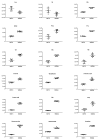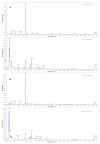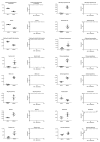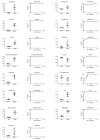Human Melanoma-Cell Metabolic Profiling: Identification of Novel Biomarkers Indicating Metastasis
- PMID: 32244549
- PMCID: PMC7177954
- DOI: 10.3390/ijms21072436
Human Melanoma-Cell Metabolic Profiling: Identification of Novel Biomarkers Indicating Metastasis
Abstract
Melanoma is the most aggressive type of skin cancer, leading to metabolic rewiring and enhancement of metastatic transformation. Efforts to improve its early and accurate diagnosis are largely based on preclinical models and especially cell lines. Hence, we herein present a combinational Nuclear Magnetic Resonance (NMR)- and Ultra High Performance Liquid Chromatography-High-Resolution Tandem Mass Spectrometry (UHPLC-HRMS/MS)-mediated untargeted metabolomic profiling of melanoma cells, to landscape metabolic alterations likely controlling metastasis. The cell lines WM115 and WM2664, which belong to the same patient, were examined, with WM115 being derived from a primary, pre-metastatic, tumor and WM2664 clonally expanded from lymph-node metastases. Metabolite samples were analyzed using NMR and UHPLC-HRMS. Multivariate statistical analysis of high resolution NMR and MS (positive and negative ionization) results was performed by Principal Component Analysis (PCA), Partial Least Squares-Discriminant Analysis (PLS-DA) and Orthogonal Partial Least Squares-Discriminant Analysis (OPLS-DA), while metastasis-related biomarkers were determined on the basis of VIP lists, S-plots and Student's t-tests. Receiver Operating Characteristic (ROC) curves of NMR and MS data revealed significantly differentiated metabolite profiles for each cell line, with WM115 being mainly characterized by upregulated levels of phosphocholine, choline, guanosine and inosine. Interestingly, WM2664 showed notably increased contents of hypoxanthine, myo-inositol, glutamic acid, organic acids, purines, pyrimidines, AMP, ADP, ATP and UDP(s), thus indicating the critical roles of purine, pyrimidine and amino acid metabolism during human melanoma metastasis.
Keywords: MS; NMR; biomarker; cancer; melanoma; metabolomics; metastasis.
Conflict of interest statement
The authors declare that have no competing financial and/or non-financial interests.
Figures













Similar articles
-
Metabolomics of papillary thyroid carcinoma tissues: potential biomarkers for diagnosis and promising targets for therapy.Tumour Biol. 2016 Aug;37(8):11163-75. doi: 10.1007/s13277-016-4996-z. Epub 2016 Mar 2. Tumour Biol. 2016. PMID: 26935059
-
Metabolic profiling of human colorectal cancer using high-resolution magic angle spinning nuclear magnetic resonance (HR-MAS NMR) spectroscopy and gas chromatography mass spectrometry (GC/MS).J Proteome Res. 2009 Jan;8(1):352-61. doi: 10.1021/pr8006232. J Proteome Res. 2009. PMID: 19063642
-
Study on plasmatic metabolomics of Uygur patients with essential hypertension based on nuclear magnetic resonance technique.Eur Rev Med Pharmacol Sci. 2014;18(23):3673-80. Eur Rev Med Pharmacol Sci. 2014. PMID: 25535139
-
Metabolomics technology and their application to the study of the viral infection.J Matern Fetal Neonatal Med. 2014 Oct;27 Suppl 2:53-7. doi: 10.3109/14767058.2014.955963. J Matern Fetal Neonatal Med. 2014. PMID: 25284178 Review.
-
Screening of synthetic PDE-5 inhibitors and their analogues as adulterants: analytical techniques and challenges.J Pharm Biomed Anal. 2014 Jan;87:176-90. doi: 10.1016/j.jpba.2013.04.037. Epub 2013 May 6. J Pharm Biomed Anal. 2014. PMID: 23721687 Review.
Cited by
-
Plasma metabolomic analysis of human hepatocellular carcinoma before and after transcatheter arterial chemoembolization.Int J Med Sci. 2024 Jan 1;21(2):413-423. doi: 10.7150/ijms.89141. eCollection 2024. Int J Med Sci. 2024. PMID: 38169572 Free PMC article.
-
Upregulated phospholipase D2 expression and activity is related to the metastatic properties of melanoma.Oncol Lett. 2022 May;23(5):140. doi: 10.3892/ol.2022.13260. Epub 2022 Mar 9. Oncol Lett. 2022. PMID: 35340556 Free PMC article.
-
Recent Advances in Mass Spectrometry-Based Structural Elucidation Techniques.Molecules. 2022 Sep 30;27(19):6466. doi: 10.3390/molecules27196466. Molecules. 2022. PMID: 36235003 Free PMC article. Review.
-
Skin Cancer Metabolic Profile Assessed by Different Analytical Platforms.Int J Mol Sci. 2023 Jan 13;24(2):1604. doi: 10.3390/ijms24021604. Int J Mol Sci. 2023. PMID: 36675128 Free PMC article. Review.
-
Study on Closely Related Citrus CMMs based on Chemometrics and Prediction of Components-Targets-Diseases Network by Ingenuity Pathway Analysis.Evid Based Complement Alternat Med. 2022 Mar 31;2022:1106353. doi: 10.1155/2022/1106353. eCollection 2022. Evid Based Complement Alternat Med. 2022. PMID: 35529921 Free PMC article.
References
MeSH terms
Substances
Grants and funding
LinkOut - more resources
Full Text Sources
Medical

